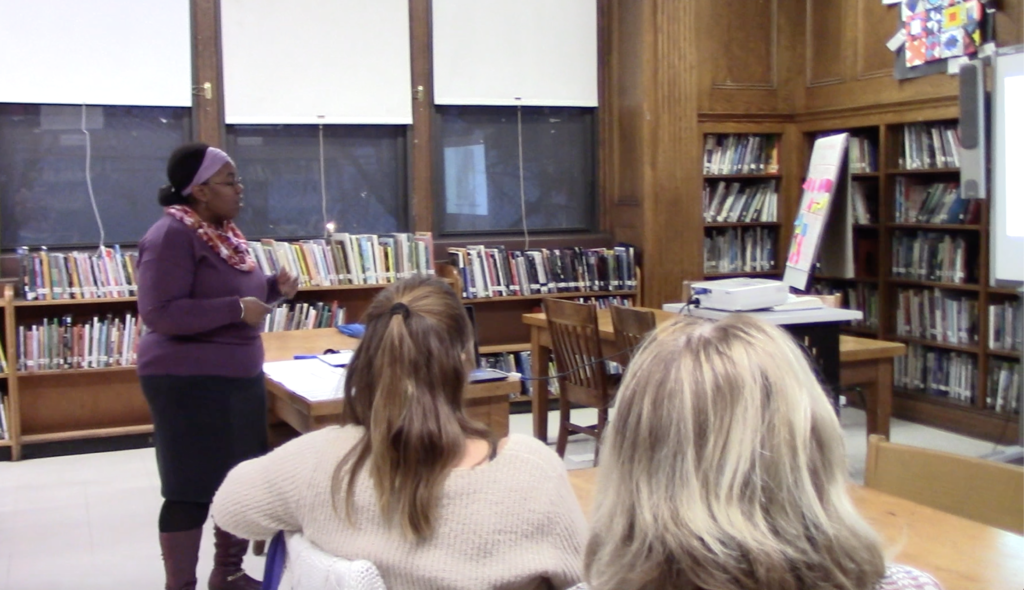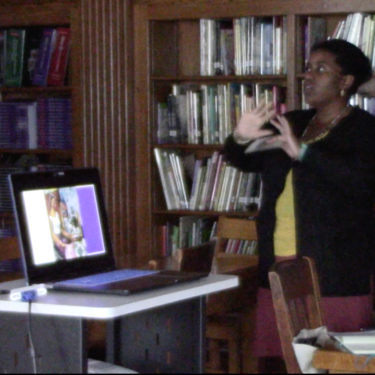On March 11th, 2020, the Providence Public schools in Rhode Island were to have a district-wide professional development day for all content areas. I saw this as an opportunity to offer a year one Visual Thinking Strategies training for a small cohort of faculty from our Turnaround Arts schools. This meeting marked my last in-person training, for two days later our district, like so many others, would close schools for the remainder of the year due to the coronavirus pandemic. I was engaged in onsite VTS visits on the day of the announcement, and began helping one of the teachers I was visiting to distribute Chromebooks to her students for distance learning.
As a Turnaround Arts implementation coordinator, I support arts integration work at schools, which includes partnerships with teaching artists, artistic engagements, and professional development for teachers at three of the district’s middle schools. VTS was one of the provisions of our partnership with Turnaround Arts, and over the course of three years, teachers of various content areas were to receive facilitator training. However, now we were in lockdown in our respective homes, communicating with students and one another no longer in person, but through phone call, text, email, and videoconferencing. And then there was the concept of online video conferencing, which sent educators to school again – to understand all the features of Google Meet or Zoom. And on top of grappling with this new location and framework for instruction, it presented the challenge: How do we hold Visual Thinking Strategies image discussions online?
I began addressing this question by first exploring the elements of an image discussion that need to be virtually reconstructed: a gathering space (video conference rather than a classroom), the capacity to point (cursor movement through mouse or trackpad), and projection of an image (screenshare). Once I pinpointed these elements, I created a video tutorial for our district’s facilitators to use when they were able to manage image discussions with their classes.
After this work, one teacher-facilitator shared a student response with me – the student submitted a Google slideshow as a response to “what was going on in the picture” and this was heartening, but I had no idea how a VTS would unfold in reality with a class of middle schoolers. The guidelines were still mostly in my head, and there was much learning I had to do.
 I ended up providing several “Introduction to Zoom” workshops for fine arts teachers, so we could, together, examine some of the features available on the Zoom platform and consider how to use those tools in class. And then, behold, the VTS Look Club – Online. I attended a few of these sessions as well, and with this practical knowledge of experiencing online image discussions, and more familiarity with the Zoom platform, it made me realize that my next step was to run a Look Club or online VTS image discussion for our facilitators in Providence. As the facilitator-teachers in attendance took notes during our session, there were real issues brought up – students are not able to meet with their classmates at a designated time. Many leave their cameras off, or their internet connections are spotty or laggy. But teachers clearly wanted to know how to facilitate VTS as part of their distance learning instruction. [Ed: For more on leading VTS discussions over Zoom, see the author’s Thoughts for Videoconferencing Image Discussions (pdf).]
I ended up providing several “Introduction to Zoom” workshops for fine arts teachers, so we could, together, examine some of the features available on the Zoom platform and consider how to use those tools in class. And then, behold, the VTS Look Club – Online. I attended a few of these sessions as well, and with this practical knowledge of experiencing online image discussions, and more familiarity with the Zoom platform, it made me realize that my next step was to run a Look Club or online VTS image discussion for our facilitators in Providence. As the facilitator-teachers in attendance took notes during our session, there were real issues brought up – students are not able to meet with their classmates at a designated time. Many leave their cameras off, or their internet connections are spotty or laggy. But teachers clearly wanted to know how to facilitate VTS as part of their distance learning instruction. [Ed: For more on leading VTS discussions over Zoom, see the author’s Thoughts for Videoconferencing Image Discussions (pdf).]
Thankfully, soon after this discussion, I was able to attend a Zoom image discussion with a group of sixth graders. Their teacher prepared the students with several reminders of the meeting, and held some image discussions with them prior to my visit. Here I learned how home life and distance learning converge, and VTS image discussions are no exception. During the course of the dialogue we experienced substantial periods of silence as we waited for the rest of a student’s comment – we heard something, but we’re not quite sure what – are they frozen? Did their internet drop? Later in the conversation, a toddler-like voice wails into the microphone and a nearby student, perhaps the sibling, whisper-yells “Quiet!” But students and teacher, unphased by this convergence find a way to keep the discussion going: the chat box bounces with responses to the image, the teacher tells everyone to unmute their microphones so they’re live when ready to speak, one student takes charge of his classmates in order to help the process. “Bryan are you in?” “Everybody, unmute yourself!” “No, that was Justin speaking.” And after the umpteenth “Quiet!” to the child’s wails, a distinct grunt is heard of the kind when one picks up a child, followed by calmer, happier prattles.
As I left the conversation with students, and reflected on the amount of focus I had put into remote learning for VTS, I was reminded of – and comforted by – a factor that resonates most with me through the strategy: the quality of affirmation. The affirmation of participant’s response through paraphrase is the “I was listening: I heard you and here is the proof of that.” This particular element of VTS feels like compassion to me, compassion for another’s idea, placing upon that idea a value undressed by compliment, a bestowal of deserved space. In that same vein, I see that quality of affirmation, of room for an individual’s idea to exist, as a practice we can hold not only during our cyber-spaced image discussions, but also as we connect with one another through this major shift in living, working, and communicating with everyone.
Questions or comments? Contact us.

